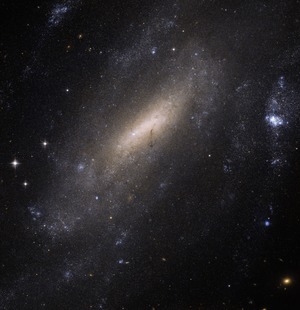IC 5201
| Galaxie IC 5201 | |
|---|---|
(c) ESA/Hubble, CC BY 4.0 | |
| Die Galaxie IC 5201, aufgenommen von dem Hubble-Weltraumteleskop | |
| AladinLite | |
| Sternbild | Kranich |
| Position Äquinoktium: J2000.0, Epoche: J2000.0 | |
| Rektaszension | 22h 20m 57,4s[1] |
| Deklination | −46° 02′ 09″[1] |
| Erscheinungsbild | |
| Morphologischer Typ | SB(s)cd / Sy2[1] |
| Helligkeit (visuell) | 10,8 mag[2] |
| Helligkeit (B-Band) | 11,5 mag[2] |
| Winkelausdehnung | 8,5/3,9[2] |
| Positionswinkel | 33°[2] |
| Flächenhelligkeit | 14,5 mag/arcmin²[2] |
| Physikalische Daten | |
| Rotverschiebung | 0.003052 ± 0.000007[1] |
| Radialgeschwindigkeit | (915 ± 2) km/s[1] |
| Hubbledistanz H0 = 73 km/(s • Mpc) | (40 ± 3) · 106 Lj (12,2 ± 0,9) Mpc [1] |
| Geschichte | |
| Entdeckung | Joseph Lunt |
| Entdeckungsdatum | 1900 |
| Katalogbezeichnungen | |
| IC 5201 • PGC 68618 • ESO 289-18 • IRAS 22179-4617 • 2MASX J22205743-4602090 • SGC 221754-4617.2 • | |
IC 5201 ist eine Balken-Spiralgalaxie vom Hubble-Typ SB(s)cd im Sternbild Kranich am Südsternhimmel. Sie ist schätzungsweise 40 Millionen Lichtjahre von der Milchstraße entfernt, hat einen Durchmesser von rund 110000 Lj. und wird als Seyfert-2-Galaxie gelistet.
Die Galaxie wurde im Jahr 1900 beiläufig von dem Astronomen Joseph Lunt entdeckt, als er am Royal Observatory nahe Kapstadt mit einem 18-Zoll-Teleskop nach Theodor Brorsens Kometen suchte.[3][4]
Weblinks
Einzelnachweise
Auf dieser Seite verwendete Medien
(c) ESA/Hubble, CC BY 4.0
A closer look at IC 5201
In 1900, astronomer Joseph Lunt made a discovery: Peering through a telescope at Cape Town Observatory, the British–South African scientist spotted this beautiful sight in the southern constellation of Grus (The Crane): a barred spiral galaxy now named IC 5201.
Over a century later, the galaxy is still of interest to astronomers. For this image, the NASA/ESA Hubble Space Telescope used its Advanced Camera for Surveys (ACS) to produce a beautiful and intricate image of the galaxy. Hubble’s ACS can resolve individual stars within other galaxies, making it an invaluable tool to explore how various populations of stars have sprung to life, evolved, and died throughout the cosmos.
IC 5201 sits over 40 million light-years away from us. As with two thirds of all the spirals we see in the Universe — including the Milky Way, the galaxy has a bar of stars slicing through its centre.
Credit:
ESA/Hubble & NASA
Coordinates Position (RA): 22 20 59.18 Position (Dec): -46° 2' 2.16" Field of view: 3.27 x 3.38 arcminutes Orientation: North is 112.8° left of vertical
Colours & filters Band Wavelength Telescope Optical V 606 nm Hubble Space Telescope ACS Optical I 814 nm Hubble Space Telescope ACS.

